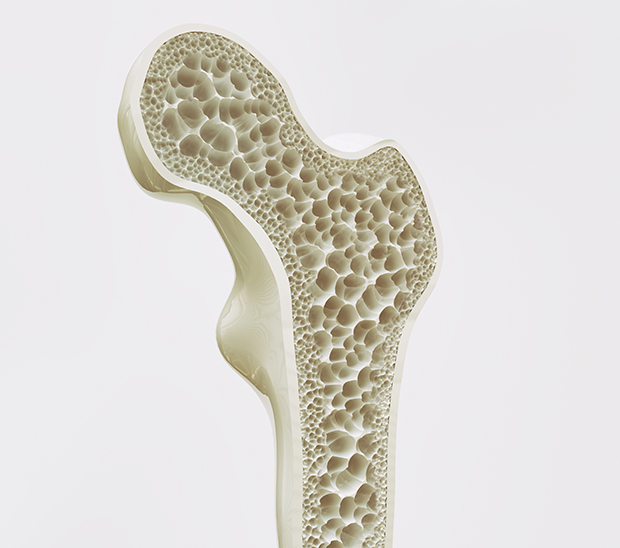
Submitted by Elizabeth Madlem, APN, The Bone Health Clinic at Millennium Pain Center
Osteoporosis is a disease that thins and weakens the bones to the point that they become fragile and can break easily — even as a result of a minor bump or fall. Osteoporosis has been called a childhood disease with consequences in old age because building healthy bones in youth can help prevent the disease later in life. It is known as a “silent disease” because, if undetected, it can progress for many years without symptoms until a fracture occurs.
Most people are aware of the common risk factors for developing osteoporosis, which include being a post-menopausal woman, having a relative with osteoporosis, living a sedentary lifestyle, smoking, and poor nutrition — especially getting inadequate amounts of Calcium and Vitamin D. Many people do not realize that there are many other medical conditions that can also cause bone loss and lead to osteoporosis. Following are five that are most common.
- Asthma
Asthma itself does not increase your risk of developing osteoporosis, but the medications used to treat it do. Approximately 20 million people in the U.S. have asthma, including some 9 million children under the age of 18. Many people with asthma use corticosteroids — such as asthma “inhalers” — to help control their disease. During asthma attacks, it is not uncommon to start drugs like prednisone for small periods of time. These are very effective in relieving the shortness of breath and wheezing that are common with asthma or emphysema, but they may also contribute to bone loss as they can decrease calcium absorbed from food, increase calcium lost from the kidneys, and decrease bone formation. In addition to this, many young people with asthma may have more difficulty participating in some activities, which means they might not get as much weight-bearing exercise as they need to help build bone. - Diabetes
Type 1 diabetes is linked to low bone density, although researchers don’t know exactly why. Insulin, which is deficient in type 1 diabetes, may promote bone growth and strength. The onset of type 1 diabetes typically occurs at a young age when bone mass is still increasing. It is possible that people with type 1 diabetes achieve lower peak bone mass, the maximum strength and density that bones reach. People usually reach their peak bone mass by age 30. Low peak bone mass can increase one’s risk of developing osteoporosis later in life. It is also possible that cytokines, substances produced by various cells in the body, play a role in the development of both type 1 diabetes and osteoporosis.
- Lupus and rheumatoid arthritis
People with these auto-immune conditions are at increased risk for osteoporosis for many reasons. To begin with, the glucocorticoid medications often prescribed can trigger significant bone loss. In addition, pain and loss of joint function can result in inactivity, further increasing osteoporosis risk. Studies also show that bone loss in rheumatoid arthritis may occur as a direct result of the disease. The bone loss is most pronounced in areas immediately surrounding the affected joints. Of concern is the fact that women, a group already at increased risk for osteoporosis, are two to three times more likely than men to have rheumatoid arthritis as well. There are many other autoimmune diseases that also promote bone loss due to the inflammatory chemicals (cytokines) that are released. - Celiac disease or gluten intolerance
People who have celiac disease cannot consume any foods containing gluten or their immune systems respond by attacking and damaging the lining of the small intestine. Some people have a gluten intolerance, which means they suffer many of the same symptoms as those with celiac disease if they eat foods that contain gluten. Symptoms vary and may include diarrhea, abdominal pain, weight loss, joint pain, headaches, fatigue, and irritability, among others. A person with celiac disease is at a much higher risk of developing osteoporosis because when the lining of the small intestine is damaged, so is its ability to absorb calcium and other vital nutrients that are essential for building bone mass in young people and maintaining healthy bones in adults. Therefore, even though a person with celiac disease may be consuming plenty of calcium, the body cannot absorb it properly, thus greatly increasing the risk of osteoporosis. Some other digestive disorders such as IBS and Crohn’s can also cause bone loss. - Over or under-active thyroid
Thyroid problems can cause a wide variety of symptoms. If there is too much thyroid hormone produced, the rate of bone loss is also increased. If too little thyroid hormone is produced, the medications typically used to control the condition can also result in bone loss.
If you have one of these conditions, it’s important to be aware of the connection to osteoporosis. You don’t want to add a medical problem to one that you already have, so work with your doctor to take the necessary steps to prevent bone loss. If you have been diagnosed with osteoporosis or have many risk factors for developing the disease, a comprehensive osteoporosis treatment program that includes a focus on lifestyle changes, can be very beneficial in helping you to improve your health.
For more information on osteoporosis, you may contact The Bone Health Clinic at Millennium Pain Center, 309-662-4321. They have a new location at 2406 East Empire St. in Bloomington, next to Orthopedic & Sports Enhancement Center. Elizabeth Madlem is a certified bone health consultant. The clinic provides screening, diagnosis, and a comprehensive treatment plan for people who have or are at risk of developing osteoporosis.

